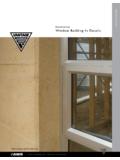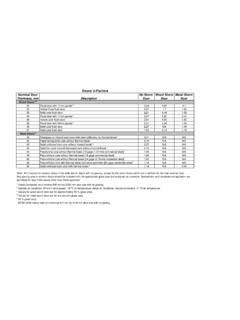Transcription of Cisco 200 Series Smart Switch Administration Guide 1.3.0
1 Administration . Guide . Cisco Small Business 200 Series Smart Switch Administration Guide Release Contents Chapter 1: Getting Started 1. Starting the Web-based Configuration Utility 1. Launching the Configuration Utility 2. HTTP/HTTPS 3. Logging Out 4. Quick Start Device Configuration 5. Interface Naming Conventions 5. Window Navigation 7. Application Header 7. Management Buttons 9. Chapter 2: Status and Statistics 12. Viewing Ethernet Interfaces 12. Viewing Etherlike Statistics 13. Viewing EAP Statistics 14. Managing RMON 16. Viewing RMON Statistics 16. Configuring RMON History 18. Viewing the RMON History Table 19. Defining RMON Events Control 20. Viewing the RMON Events Logs 22. Defining RMON Alarms 22. Chapter 3: Administration : System Log 26. Setting System Log Settings 26.
2 Setting Remote Logging Settings 28. Viewing Memory Logs 29. RAM Memory 30. Flash Memory 30. Chapter 4: Administration : File Management 32. System Files 32. Cisco Small Business 200 Series Smart Switch Administration Guide 2. Contents Upgrade/Backup Firmware/Language 35. Upgrade/Backing Firmware or Language File 36. Download/Backup Configuration/Log 39. Configuration File Backwards Compatibility 39. Downloading or Backing-up a Configuration or Log File 40. Configuration Files Properties 44. Copy/Save Configuration 45. DHCP Auto Configuration 47. DHCP Server Options 48. Auto Configuration Download Protocol (TFTP or SCP) 48. SSH Client Authentication Parameters 48. Auto Configuration Process 49. Configuring DHCP Auto Configuration 50. Chapter 5: Administration : General Information 54.
3 Device Models 54. System Information 56. Displaying the System Summary 56. Configuring the System Settings 57. Rebooting the Device 58. Monitoring Fan Status 60. Defining Idle Session Timeout 61. Pinging a Host 62. Chapter 6: Administration : Time Settings 64. System Time Options 65. Time 65. Time Zone and Daylight Savings Time (DST) 66. SNTP Modes 66. Configuring System Time 67. Selecting Source of System Time 67. Cisco Small Business 200 Series Smart Switch Administration Guide 3. Contents Adding a Unicast SNTP Server 69. Configuring the SNTP Mode 72. Defining SNTP Authentication 72. Chapter 7: Administration : Diagnostics 74. Testing Copper Ports 74. Displaying Optical Module Status 76. MSA-compatible SFPs 76. Configuring Port and VLAN Mirroring 77. Viewing CPU Utilization and Secure Core Technology 79.
4 Chapter 8: Administration : Discovery 80. Configuring Bonjour Discovery 80. Bonjour in Layer 2 System Mode 80. LLDP and CDP 81. Configuring LLDP 82. LLDP Overview 83. Setting LLDP Properties 84. Editing LLDP Port Settings 85. LLDP MED Network Policy 87. Configuring LLDP MED Port Settings 89. Displaying LLDP Port Status 90. Displaying LLDP Local Information 91. Displaying LLDP Neighbors Information 95. Accessing LLDP Statistics 99. LLDP Overloading 100. Configuring CDP 102. Setting CDP Properties 102. Editing CDP Interface Settings 105. Displaying CDP Local Information 106. Displaying CDP Neighbors Information 108. Viewing CDP Statistics 110. Cisco Small Business 200 Series Smart Switch Administration Guide 4. Contents Chapter 9: Port Management 112. Configuring Ports 112.
5 Setting Port Configuration 113. Configuring Link Aggregation 116. Link Aggregation Overview 116. Load Balancing 116. Default Settings and Configuration 117. Static and Dynamic LAG Workflow 118. Defining LAG Management 118. Configuring LAG Settings 119. Configuring LACP 121. LACP Priority and Rules 121. LACP With No Link Partner 121. Setting LACP Parameter Settings 122. Configuring Green Ethernet 123. Green Ethernet Overview 123. Power Saving by Disabling Port LEDs 124. Energy Efficient Ethernet Feature 125. Setting Global Green Ethernet Properties 127. Setting Green Ethernet Properties for Ports 128. Chapter 10: Smartport 132. Overview 132. What is a Smartport 133. Smartport Types 133. Special Smartport Types 135. Smartport Macros 136. Applying a Smartport Type to an Interface 136.
6 Macro Failure and the Reset Operation 137. How the Smartport Feature Works 138. Auto Smartport 138. Enabling Auto Smartport 139. Cisco Small Business 200 Series Smart Switch Administration Guide 5. Contents Identifying Smartport Type 139. Using CDP/LLDP Information to Identify Smartport Types 140. Multiple Devices Attached to the Port 141. Persistent Auto Smartport Interface 142. Error Handling 142. Default Configuration 142. Relationships with Other Features and Backwards Compatibility 143. Common Smartport Tasks 143. Configuring Smartport Using The Web-based Interface 145. Smartport Properties 146. Smartport Type Settings 147. Smartport Interface Settings 148. Built-in Smartport Macros 150. Chapter 11: Port Management: PoE 162. PoE on the Device 162. PoE Features 162.
7 PoE Operation 163. PoE Configuration Considerations 163. Configuring PoE Properties 165. Configuring PoE Settings 166. PoE priority example: 166. Chapter 12: VLAN Management 170. VLANs 170. Configuring Default VLAN Settings 173. Creating VLANs 174. Configuring VLAN Interface Settings 175. Defining VLAN Membership 176. Configuring Port to VLAN 177. Configuring VLAN Membership 178. Voice VLAN 179. Cisco Small Business 200 Series Smart Switch Administration Guide 6. Contents Voice VLAN Overview 179. Dynamic Voice VLAN Modes 181. Voice End-Points 182. Auto Voice VLAN, Auto Smartports, CDP, and LLDP 182. Voice VLAN QoS 184. Voice VLAN Constraints 184. Voice VLAN Workflows 185. Configuring Voice VLAN 186. Configuring Voice VLAN Properties 186. Displaying Auto Voice VLAN Settings 188.
8 Configuring Telephony OUI 190. Adding OUIs to the Telephony OUI Table 190. Adding Interfaces to Voice VLAN on Basis of OUIs 191. Chapter 13: Spanning Tree 194. STP Flavors 194. Configuring STP Status and Global Settings 195. Defining Spanning Tree Interface Settings 197. Configuring Rapid Spanning Tree Settings 199. Chapter 14: Managing MAC Address Tables 202. Types of MAC Addresses 202. Configuring Static MAC Addresses 203. Managing Dynamic MAC Addresses 204. Configuring Dynamic MAC Address Aging Time 204. Querying Dynamic Addresses 204. Chapter 15: Multicast 206. Multicast Forwarding 206. Typical Multicast Setup 207. Multicast Address Properties 208. Defining Multicast Properties 209. Adding MAC Group Address 210. Adding IP Multicast Group Addresses 212. Cisco Small Business 200 Series Smart Switch Administration Guide 7.
9 Contents Configuring IGMP Snooping 214. MLD Snooping 216. Querying IGMP/MLD IP Multicast Group 218. Defining Multicast Router Ports 219. Defining Forward All Multicast 220. Defining Unregistered Multicast Settings 221. Chapter 16: IP Configuration 224. Overview 224. Layer 2 IP Addressing 224. IPv4 Management and Interfaces 225. Defining an IPv4 Interface 225. ARP 227. 228. IPv6 Global Configuration 229. IPv6 Interface 229. IPv6 Tunnel 232. Configuring Tunnels 233. Defining IPv6 Addresses 234. IPv6 Default Router List 235. Defining IPv6 Neighbors Information 236. Viewing IPv6 Route Tables 238. Domain Name 239. DNS Settings 240. Search List 241. Host Mapping 242. Chapter 17: Security 244. Defining Users 245. Setting User Accounts 245. Setting Password Complexity Rules 246.
10 Configuring RADIUS 248. Cisco Small Business 200 Series Smart Switch Administration Guide 8. Contents Defaults 248. Interactions With Other Features 249. Radius Workflow 249. Configuring Management Access Authentication 251. Defining Management Access Method 252. Active Access Profile 253. Defining Profile Rules 255. SSL Server 257. SSL Overview 257. Default Settings and Configuration 258. SSL Server Authentication Settings 258. Configuring TCP/UDP Services 259. Defining Storm Control 261. Configuring Port Security 262. Configuring 265. Parameters Workflow 265. Defining Properties 266. Defining Port Authentication 267. Defining Host and Session Authentication 269. Viewing Authenticated Hosts 270. Denial of Service Prevention 271. Secure Core Technology (SCT) 271. Types of DoS Attacks 271.















